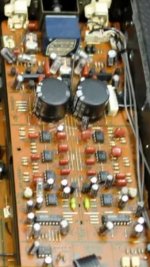Long story short, I bought a Kenwood DP-3300D CD player after I saw some internal pics of the beast. Seems very well design and constructed with what appears to be top of the line stuff all around.
TBH I dont listen to CDs, mostly I play records or stream music. For the later I was wondering to use the DP-3300D DAC portion of it by adding a Coax digital input and put the DAC part to good use.
Can some body more knowledgeable give me some north if it is possible & worth it, and if so...where to start. My DIY experience is more in the analog /solid state than in the Digital realm.
Attached is a pic of the DAC board in question and a brief description (found online)
-One per channel Burr-Brown PCM56P DAC (high-spec ‘K’ versions)
-4 per channel NE5532 opamps
-Fixed / variable output
Cheers,
Rob.
TBH I dont listen to CDs, mostly I play records or stream music. For the later I was wondering to use the DP-3300D DAC portion of it by adding a Coax digital input and put the DAC part to good use.
Can some body more knowledgeable give me some north if it is possible & worth it, and if so...where to start. My DIY experience is more in the analog /solid state than in the Digital realm.
Attached is a pic of the DAC board in question and a brief description (found online)
-One per channel Burr-Brown PCM56P DAC (high-spec ‘K’ versions)
-4 per channel NE5532 opamps
-Fixed / variable output
Cheers,
Rob.
Attachments
It is possible but two aspects of the circuit put it at the harder end of possible. Custom glue logic would be required.
Blue Rob,
1. So as not to waste a perfectly good DAC section. Please see High End Audio - Digital decoder for NOS DAC for the schematic for the necessary glue logic using 74HC164 shift register ic's.
2. I understand you are familiar with streaming. If you use a Raspberry Pi, 24 bit I2S is available from the GPIO pins. The PCM56 is a 16 bit dac.
3. For two channel I2S signal in two simple DACs, you must delay data signal for aligning to required number of bits and buffer 32bit of left-channel data for simultaneous playing of both channels.
4. You can implement it by simply delaying and buffering the data line, with 74HC164 shift registers. Use a 15 bit delay for the right channel data line for a 16bit DAC and buffer the data line by 32 bits for the left channel data line.
5. I have not implemented this on a 16 bit DAC chip but only on 18 bit and 20 bit DACs, but I think that the suggestion at para 4 will work.
See example of 7 bit delay for converting I2S to 24bit, 13bit delay for the right channel data line and by 32 bits for the left channel data line for 18bit DAC as per AD1865 based audio DAC with I2S input and voltage output
1. So as not to waste a perfectly good DAC section. Please see High End Audio - Digital decoder for NOS DAC for the schematic for the necessary glue logic using 74HC164 shift register ic's.
2. I understand you are familiar with streaming. If you use a Raspberry Pi, 24 bit I2S is available from the GPIO pins. The PCM56 is a 16 bit dac.
3. For two channel I2S signal in two simple DACs, you must delay data signal for aligning to required number of bits and buffer 32bit of left-channel data for simultaneous playing of both channels.
4. You can implement it by simply delaying and buffering the data line, with 74HC164 shift registers. Use a 15 bit delay for the right channel data line for a 16bit DAC and buffer the data line by 32 bits for the left channel data line.
5. I have not implemented this on a 16 bit DAC chip but only on 18 bit and 20 bit DACs, but I think that the suggestion at para 4 will work.
See example of 7 bit delay for converting I2S to 24bit, 13bit delay for the right channel data line and by 32 bits for the left channel data line for 18bit DAC as per AD1865 based audio DAC with I2S input and voltage output
Last edited:
